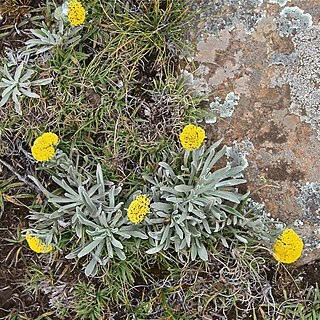Perennial herb; flowering stems 0.08-0.60 m high, several, lateral to rosettes, [tufted,] often decumbent at base or ascending, mostly simple, densely leafy. Leaves: blade of basal leaves lingulate, oblong or elliptic, 120 x 15 mm, apex obtuse or subacute, base broad, clasping, both surfaces with very close silvery silky-felted hairs; blade of stem leaves similar but smaller. Heads discoid, narrowly cylindric, 2.5-3.5 x 1.5-2.0 mm, many in small, corymbose clusters, congested in flattened, spreading, cymose corymb, the whole matted together below with closely interwoven wool. Involucral bracts in 3 or 4 series, subequal, loosely imbricate, outer brown or straw-coloured, inner tipped bright canary-yellow, ± equalling florets, not radiating, stereome divided. Receptacle epaleate, shortly honeycombed. Flowers: disc florets only, 4-13; corolla narrowly funnel-shaped, yellow; Mar.-Jun. Fruit with cypsela glabrous. Pappus of few delicate bristles with shortly plumose tips, bases nude, not cohering.
Perennial herb, indumentum close, silvery felted, 1-several leaf rosettes, stems lateral, 80-600 mm long, decumbent or ascending, simple, leafy. Leaves: radical leaves up to 120 x 15 mm, apex obtuse or subacute, base broad, clasping; cauline leaves similar, smaller upwards, spreading or imbricate. Capitula narrowly cylindric, 2.5-3.5 x 1.5-2.0 mm, in a flat spreading corymb 20-40 mm in diam., matted wool below; involucral bracts in 3 or 4 series, outer brown or straw-coloured, inner tipped bright yellow, translucent. Flowers 4-13, yellow. Flowering time Mar.-June. Pappus of 5-7 bristles, not cohering. Cypselae 0.75 mm long, narrow.
Perennial herb, 0.08-0.60 m high. Leaves in a basal rosette and cauline, lingulate, oblong or elliptic, base clasping, both surfaces silvery silky-felted. Heads narrowly cylindric, many in small corymbose clusters.congested in flattened spreading cymose corymb. Flowers yellow; outer involucral bracts brown or straw-coloured, inner tipped bright canary-yellow.
Tufted, silvery felted perennial to 60 cm from a woody rootstock. Leaves oblanceolate, silvery felted but hairs almost skin-like. Flower heads discoid, densely matted together in terminal cymes, narrowly cylindric, yellow, ± 3 x 2 mm, florets 4-13, ovary glabrous.

